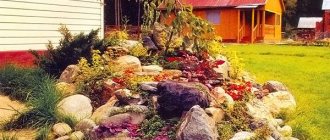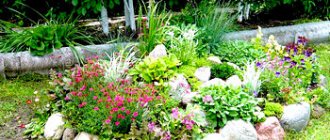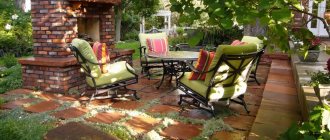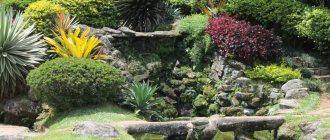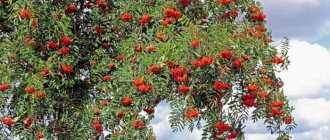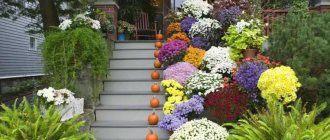Photos of alpine slides are often found in garden design magazines. This is not surprising; this attribute is becoming increasingly popular.
The reason for this is its unusual shape and variety of colors. Such an “island” on the site helps to create an elegant and aristocratic atmosphere.
Basic postulates
When choosing a place in the country for an alpine slide, experienced designers advise paying attention to the following factors:
- the basic principle of building a rock garden is the absence of symmetry, the design of two or three differences in height;
- choose a place with maximum sun exposure. Its deficiency will lead to the loss of bright colors in the flower garden and, in addition, the plants will stretch out, become thinner, and the stone garden will lose its attractiveness;
- proximity to trees will bring unnecessary trouble, as falling leaves will spoil the appearance of the alpine slide;
- when arranging, rely on stones of unusual shapes. If they are gray, surround them with bright colors.
Whatever type of rocky flowerbed you choose, you will need a standard set of plants and stones.
Rock garden in miniature. Step by step guide
- Selecting a base for a rock garden.
The material must be dense and frost-resistant. You can use metal utensils or stone bowls. The bottom must have drainage holes.
A miniature alpine slide can also be located in a small wooden flower bed Source luas.in
- Filling with a drainage layer.
After choosing a container, drainage is placed at the bottom (you can use fragments of ceramics or gravel). The drainage layer ensures unimpeded exit of water from the container (water should not stagnate). But it is worth remembering that the fragments should not fit tightly to each other (there should be space between them).
- Preparation and laying of the substrate.
The next step is to fill the container with substrate. It can be made from peat, sand and soil, mixing everything in equal parts. Then the layer should be watered generously. If this is not enough, you can add an additional layer of substrate, but it should not reach the very edges of the container.
- Selection and installation of stones.
The choice of stones plays an important role. They should be small in size, smooth, without mechanical damage, and of the same style. The stones are laid as in a large rock garden (first large ones, then smaller ones). The space is filled with soil. At the top of the slide you can install one large decorative stone.
- Planting plants and flowers.
Stone, flowers and water
The basic principle of a rock garden is the arrangement of flowers and stones: the largest stones are located at the top, creeping types of flowers and small stones live at the foot.
The slide always (except in winter, of course) looks original and compact. Flowers can be placed on artificial terraces seasonally.
And the rock garden also surprises owners as an unusual landscape find: it is created not only in the form of a flower bed, but also on a terrace, porch or in a flowerpot.
We recommend reading:
- Effective Weed Killer - Review of the Best Weed Removal Products and Methods. Geotextiles and rules for their installation (145 photos and videos)
Flowers for a flower bed that bloom all summer - a review of unpretentious types of flowers for the whole summer (85 photos)
Do-it-yourself trellis - 110 photos on how to make it yourself and video tips for use in landscape design
If space, time and technical means allow, the owners create a slide and a pond in the complex. Sometimes even with a waterfall. To do this, you will need certain tools, an old bathtub or other container, and special instructions from the Internet.
We won’t go into detail here; our task is to tell you how to make an alpine slide in the easiest way.
To start arranging a rock garden, a summer resident needs to decide which option he would like to see on his site:
- an alpine slide in a flowerpot is an original solution for a summer house with a small piece of land. The mobile structure can easily be moved indoors for the winter;
- a typical rock garden is located in terraces in open space;
- the third option is the most time-consuming, but also the most effective: a rocky flowerbed with a pond, waterfall or fountain.
Selecting a location
The technology for creating a rock garden involves a phased division of work.
To avoid mistakes when arranging it, novice gardeners are advised to follow the step-by-step instructions.
Find a place for the future flower garden away from trees and drainpipes. In the first case, the foliage will cover the rocky garden, in the second, the water will wash away our structure.
We recommend reading:
Laying artificial turf with your own hands: how to choose and step-by-step description of how to lay a lawn (100 photos)How to lay rolled lawn - step-by-step master class and tips on how to lay rolled lawn correctly (120 photos + video)
The best flower clock - a step-by-step description of how to make a beautiful element of landscape design correctly
If there is a slope at your summer cottage, it will be an ideal place for an alpine slide. It is easy to recreate terraces here and even build a small waterfall. On a level area, an embankment of soil and stones is created artificially.
To avoid mistakes with sizes, landscape designers recommend sticking to a percentage ratio of 1:10. That is, if the plot is 6 acres, a rock garden with a height of 60-100 cm does not go beyond the boundaries of 6-8 square meters.
Planning
When the location of the unusual flower bed has been determined, we begin planning the future flower garden. It is best to do this on paper, depicting stones and islands of plants in exact accordance with the scale of the territory. This will help you choose the right green spaces based on shades (you will need multi-colored pencils) and flowering times.
You can use ready-made diagrams or come up with something completely unusual, focusing on your own preferences, the illumination of the area and the size of the allocated area.
Selection of stones
Is it worth mentioning that when building a natural mountain landscape, only natural materials are suitable. Only garden figurines can be artificial to decorate the finished slide.
For the rock garden, durable and moisture-resistant stones are selected. Granite and large crushed stone are suitable. And layered sandstone perfectly imitates mountain ledges.
Rocky-flower composition
Construction begins in the spring or summer, so that by autumn its formation is completed and the flowers have time to take root.
A pit is dug 20 cm deep.
If you want to decorate a rock slide with a small pond, now is the time to install it. The presence of an artificial lake will significantly enliven the overall appearance of the slide. Tips on setting up a mini-pond can be found in many articles.
The bed under the rock garden is filled with fine pebbles in a layer of 15-20 cm. Broken bricks and construction waste (of course, without harmful impurities) are suitable for this purpose.
A layer of fertile soil with the addition of fine gravel is poured on top. To compact the layers of soil and drainage, they are filled with water. This is done to ensure that the structure does not sag over time.
Next, the stones are installed. Please note that the principle of building an alpine slide is based on descending. The largest boulder is located at the top, the smallest ones are at the foot. The higher the composition, the more stones are used to create it.
Installing large boulders and layered terraces will require holding them together with cement or clay mixed with soil.
Repeat the mountain landscape by creating a copy of it on your site. Model tiny gorges, plateaus, cliffs, cliffs and terraces on the slide.
Do-it-yourself Alpine slide: step-by-step photos, diagrams and construction features
Before starting work, landscape design is thought through. Do-it-yourself Alpine slides, photos of which can be seen in the photo gallery, require a special approach and a well-planned project. When choosing a suitable site for construction, the proximity of groundwater passage is important. If they are located close together, the strength and durability of the structure is threatened. The groundwater level is influenced by special drainage.
A well-thought-out project will help during installation work
Soil and drainage preparation
To make a beautiful alpine slide with your own hands, step-by-step photo instructions and diagrams will help you complete the installation.
Marking the contour and digging a trench for laying stones
The stability of the structure depends on the quality of the drainage system
First of all, the drainage system is performed:
- To do this, a pit is dug larger than the site;
- Before this stage, the terrain is marked, which is done using a coil of wire and special wedges;
- the height of the trench should not be less than 0.9 meters;
- the created depression is filled with crushed stone;
- the resulting layer is filled with water;
- then a sand and gravel composition is laid, which is compacted;
- the extracted layer of soil is cleaned and added on top of the constructed structure.
Stone laying can begin after the structure has settled. This may take about four months.
Helpful advice! You can add crushed stone to garden soil, and add sand to clay soil.
The drainage system diagram includes several layers
How to place the stones?
An alpine slide is made from stones with your own hands. Step-by-step photos, diagrams and drawings will help you choose the best design project. Before laying the stones, it is worth preparing a special mixture. In this case, coarse sand, loam from the garden and compost are used. Crushed gravel is also used.
The method of laying the stones depends on the type of project planned
A similar composition can be distributed over the drainage. After this, the mixture is moistened and trampled. Large stones are installed first, and then smaller ones. When constructing, you should use the following recommendations:
- layers of stones should be laid parallel;
- the upper stones must be installed on the lower blocks, but not on the soil, as this will cause the sculpture to skew;
- if you plan to plant plants with a powerful root system, then you should leave space between the blocks for them;
- voids should be filled with soil.
The use of stones of various sizes should be combined with the plants being planted
The stones must be laid so that the soil between them does not erode during heavy rainfall. Sandstones, limestones and basalt with granite are used in the construction of this structure. Experts do not recommend using shell rock or tuff.
Helpful information! To retain moisture for plants, the surface of the rock garden can be sprinkled with gravel or stone chips.
Compacting the soil is a mandatory step before laying stones
Creating compositions with large boulders will require help
Video: DIY rock garden construction
General form
When the stones are installed and the spaces between them are filled with soil, it is time to start landscaping on the rocky area.
To harmoniously place plants, professionals advise not to plant flowers right away. Place pots with plants around the rock garden, move them, look for the most advantageous location, and design a harmonious composition.
While the plants are not planted in the ground, pay attention to the finished appearance of the living structure. The overall picture should resemble a natural landscape - stepped rocky terraces with a colorful plant carpet and shady hollows.
What time of year is suitable for creating a flower garden?
The work performed to install the slide practically does not depend on the time of year. It is not recommended to start work in winter. The best period is considered to be autumn, when there is time before cleaning the area for the winter. A rocky structure after installation requires time for a certain shrinkage. After this, you can only start planting plants. If the plants are planted in the fall, then the construction of the main structure can begin in the spring. A high-quality alpine slide is created with your own hands using step-by-step photos and diagrams.
The best time period for planting mountain crops is autumn
Greens for stones
What distinguishes a rock garden from an ordinary flower garden is a well-chosen set of floral, coniferous and artisanal plants.
The main requirements for it are decorative qualities, unpretentiousness, long flowering. When planting flora, it is advised to take into account the ratio: 1 coniferous plant, 2 shrubs, 3-4 flowering plants. They are planted starting from the top, gradually descending to the foot. The soil around the plants is mulched with fine crushed stone. This will retain moisture and protect the sprouts from weeds.
Not all flowers growing in flower beds are suitable for alpine hills. Preference is given to perennial, slow-growing and frost-resistant species. According to the growth form, low-growing, creeping and ground cover flowers are chosen.
The rock garden is visually divided into three tiers and each has its own climatic conditions.
The upper tier is more susceptible to winds and drought than others. Therefore, you need to place flowers on it that love the sun and are not afraid of drafts and lack of moisture. These can be edelweiss, bergenia, echinacea and lavender.
The average level is characterized by moderate humidity and not much light. Chest, Carpathian bell, hosta, purslane and young (stone rose) feel good in such conditions. The last two species are ideal settlers for a stone hill. They live well in rocky crevices.
Plants that love moisture and shade will take root on the third tier. Indian duchesnea, primrose, thyme (thyme), awl-shaped phlox, and saxifrage will bloom in lush colors in such conditions.
Also, to simulate a natural landscape, carnations, cinquefoil (St. John's wort), violet, low-growing iris, rhodiola, periwinkle and marigolds are planted.
Plants
Flowers for an alpine slide should not have a capricious character. It should also be taken into account that the top of the slide will dry out much faster than the lower level. Therefore, for the top you should choose plants that can easily withstand a slight drought.
For a small alpine slide, the most often chosen are:
- modest forget-me-nots;
- various saxifrages;
- bright daffodils;
- fluffy primroses:
- delicate violets;
- exotic edelweiss;
- lovely Turkish carnations.
All ground cover perennials will look great. On large hills you can plant dwarf pine or juniper bushes.
The rock garden does not like bare ground, so the entire space should be planted with plants or covered with stones.
Harvest on the stones
Did you know that sometimes an alpine slide is made not only for flowering plants? The originals plant vegetables on it.
True, the composition has to be removed every autumn. But there is a practical use for the tiny rock garden area.
Parsley, basil, mint, lettuce, dill, and lemon balm are planted on the vegetable rock. Tomatoes, eggplant, peppers, and strawberry bushes will add bright colors. Such a hill will require more care than a flower one, since it needs to be fertilized, weeded and harvested.
Numerous master classes on creating an alpine slide, photos from the Internet will inspire you to create a wonderful recreation area in your summer cottage.
And don’t let the small difficulties associated with its construction scare you. The reward will be the admiration of friends and acquaintances and the pleasure of contemplating the work of your hands.
On summer evenings, sitting near a rock garden with a pond, what could be better than enjoying the peace, listening to the murmur of water and the croaking of a frog that has settled in the pond.
Do-it-yourself Alpine slides at the dacha: photos of the best compositions
Mountain structures can be used in various variations. Based on the photo, you can choose the most interesting options:
- the composition of a valley in the highlands reflects the appearance of a high plateau, with large stones buried two-thirds into the soil and complemented by bushes of different heights and winding paths;
The valley requires the use of a large number of stones of the same type
- large blocks are required when creating a rock cliff, in this case dwarf fern, mountain pine and juniper are planted;
The rock composition is made using natural hills
- if there is a slope, you can arrange a mountain slope, which is formed using dwarf pines and heather;
If you are not satisfied with the uneven landscape, then you can disguise it with a similar composition
- the composition in the form of a gorge is characterized by complexity, while a landscape of different heights is used and the hillocks are lined with boulders;
To implement such an idea will require a large amount of time and materials.
- when constructing a ravine in a forest, fontanel and perennial plants are suitable;
A small ravine will allow you to construct a unique and natural composition
- if the area is constantly moist, then you can use a swamp composition, which is formed using a pond;
A small pond will add originality to landscape design
- An original solution is considered to be a cascading stream, along the banks of which primroses, ferns and irises are planted.
Water flowing in cascades can decorate any recreation area
Helpful information! The classic solution is a centric structure, in which bright plant flowers are combined with rocky elements. The basis is an area with natural elevation.
